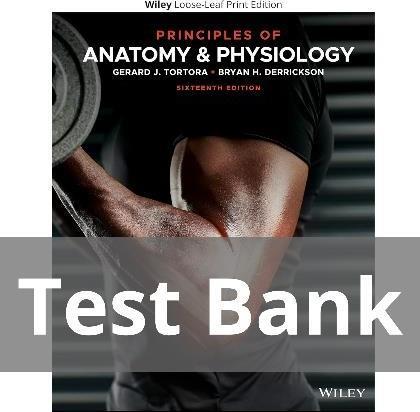https://nursingrade.com/product/principles-of-anatomy-and-physiology-16th-editionby-gerard-j-tortora-test-bank/

Chapter 01 An Introduction to the Human Body
Question type: Multiple Choice :
1) Which describes the study ofthe functions of body structures?
a) Anatomy
b) Physiology
c) Endocrinology
d) Histology
e) Immunology
Answer: b
Difficulty: Easy
Bloomcode: Knowledge
Learning Objective 1: LO 1.1 Define anatomy and physiology, and name several branches of these sciences.
Section Reference 1: Sec 1.1 Anatomyand PhysiologyDefined
Question type: Multiple Choice
2) A group ofcells that work together to performa particular function is a(n)
a) tissue.
b) organ.
c) molecules.
d) compounds.
e) organism.
Answer: a
Difficulty: Easy
Bloomcode: Knowledge
Learning Objective 1: LO1.2 Identify the locations and functions of each ofthe organ systems and major organs of the human body.
Section Reference 1: Sec 1.2 Levels ofStructural Organization and BodySystems.
https://nursingrade.com/product/principles-of-anatomy-and-physiology-16th-editionby-gerard-j-tortora-test-bank/
Questiontype: Multiple Selection
3) What process occurs when amino acids build new proteins?Select allthat apply.
a) Metabolism
b) Anabolism
c) Catabolism
d) Responsiveness
e) Differentiation
Answer 1: a
Answer 2: b
Difficulty: Medium
Bloomcode: Application
Learning Objective 1: LO1.3 Define the important life processes ofthe human body.
Section Reference 1: Sec 1.3 Characteristics of the Living Human Organism
Question type: Essay
4) How are reproduction, differentiation and growth related?
Answer:
Difficulty: Hard
Bloomcode: Synthesis
Learning Objective 1: LO1.3 Define the important life processes ofthe human body.
Section Reference 1: Sec 1.3 Characteristics of the Living Human Organism
Solution: Reproduction occurs through the fertilization of an ovum by a sperm cell to form a zygote, followed by repeated cell divisions and the differentiation of these cells. Growth is an increase in bodysize that results froman increase in the size ofexisting cells, an increase in the number of cells, or both.
Questiontype: Multiple Choice
5) The two organ systems that predominantly regulate and maintain homeostasis are the
a) cardiovascular and integumentarysystems.
b) nervous and endocrine systems.
c) cardiovascular and respiratorysystems.
https://nursingrade.com/product/principles-of-anatomy-and-physiology-16th-editionby-gerard-j-tortora-test-bank/
d) respiratoryand muscular systems.
e) urinaryand integumentarysystems.
Answer: b
Difficulty: Easy
Bloomcode: Comprehension
Learning Objective 1: LO1.4 Explain the importance ofhomeostasis and describe the relationship of homeostatic imbalances to disorders.
Section Reference 1: Sec 1.4 Homeostasis
6) Which body fluid fills the narrow spaces between cells and tissues?
a) Lymph
b) Blood plasma
c) Interstitial fluid
d) Intracellular fluid
e) Vitreous body
Answer: c
Difficulty: Medium
loomcode: Application
Learning Objective 1: LO1.4 Explain the importance ofhomeostasis and describe the relationship of homeostatic imbalances to disorders.
Section Reference 1: Sec 1.4 Homeostasis
Question type: Essay
7) Describe the differences between positive and negative feedback systems.
Answer:
Difficulty: Medium
Bloomcode: Analysis
Learning Objective 1: LO1.4 Explain the importance ofhomeostasis and describe the relationship of homeostatic imbalances to disorders.
Section Reference 1: Sec 1.4 Homeostasis
Solution: A positive feedback systemwill strengthen or reinforce a change in one ofthe body's controlled conditions while a negative feedback system will reverse a change in a controlled condition.
https://nursingrade.com/product/principles-of-anatomy-and-physiology-16th-editionby-gerard-j-tortora-test-bank/
Questiontype: Multiple Choice
8) Hormonal or electrical signals are sent fromthe controlcenter to the
a) receptors.
b) stimulus.
c) afferent pathway.
d) effectors.
e) efferent pathway.
Answer: d
Difficulty: Medium
Bloomcode: Application
Learning Objective 1: LO1.4 Explain the importance ofhomeostasis and describe the relationship of homeostatic imbalances to disorders.
Section Reference 1: Sec 1.4 Homeostasis
Question type: Multiple Choice
9) Acomponent that detects decreasing oxygen concentrations in blood would be the
a) receptor.
b) muscle.
c) response.
d) effector.
Answer: a
Difficulty: Medium
Bloomcode: Analysis
Learning Objective 1: LO1.4 Explain the importance ofhomeostasis and describe the relationship of homeostatic imbalances to disorders.
Section Reference 1: Sec 1.4 Homeostasis
Question type: Multiple Choice
10) If blood concentrations ofthyroid hormones increase above a certain level, Thyroid releasing hormone (TRH) neurons in the hypothalamus are inhibited and stop secreting TRH. This is an example of
